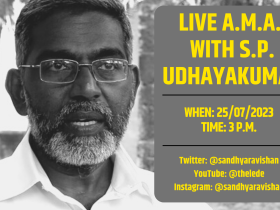By Sandhya Sridhar
It’s that special time just before dawn, when the rays of the sun cast the first bright fingers of the morning light. Women all over India are cleaning their front yards, sweeping and sprinkling water, before creating elegant rice flour drawings on the ground. Is this a scene from today, or from a thousand years ago? Or perhaps two?

Twitter user Sahana Singh made this observation a couple of years ago, watching her tenant make the rangavali or the rangoli in the tiny space before her front gate.
From the North to the South, these drawings can be freewheeling, or from one from a memory corpus handed over from generation to generation. The languages may call them by different names, as rangoli (Maharashtra), sathiya (Gujarat), muggulu (Andhra Pradesh), rangavali (Karnataka), kolam (Tamil Nadu), alpana (Bengal), aipan in the Himalayas and so on.
As with all rituals and practises and with textual literature, the handing over of the knowledge and its importance have been through a generational teaching, in an unbroken line of carrying forward the ritual memory. There are so many little rituals that we do unthinkingly just because we have been taught, not questioning where it came from and how it originated. I remember, as a girl of four or five, my grandmother teaching us how to pinch the rice flour between our thumbs and our forefingers, rolling them out to form dots, lines and whirls. We would practise endlessly on the red-oxide floor of the ancestral home, dusting away the wobbly lines and trying hard to make them straight. And one day, we did master the art, or at least a semblance of it.
One of the earliest reference to the rangoli is in the Natyasastra (thought to have written by the Rishi Bharata between 200 BCE and 200 CE), which describes how a rangavali was drawn on stage and decorated with flowers as part of the worship before the beginning of the dance performance.
Let’s also remember the line that Lakshmana drew when leaving Sita alone in the cottage and going in search of Lord Rama – a line or a form of rangoli invested with powers that would safeguard Sita from evil forces. Similarly, when Lord Rama returns triumphantly to Ayodhya after rescuing Sita, rangoli and lamps greet them.
Four thousand years ago, cities along the Vedic River Sarasvati, were inhabited by a refined and cultured people, with homes that were elegant, well-constructed. The cities themselves were laid out in geometric proportions, the homes too aligning to this geometric form, altars of worship being given importance and prominence. Rituals and practices, worship and preservation of the nature around us were in focus.
Author Narendran Thillaisthanam, in his factually well-researched book, ‘The Sarasvati Epoch’, traces the rangavali as being one of the elements that are part of the unbroken civilisational ethos of the sub-continent. He harks back to the Sarasvati Civilisation, where he talks of the rangavali being of the ‘endless knots’ design, one that was a Harappan hallmark that was ubiquitous in every home. There are surviving Harrappan seals with this ‘endless knot’ in different forms, that appear on doorsteps as rangavali even today.
It therefore, cannot be disputed that today, in the many regions of India, the rangoli patterns share commonalities. Some of the dot or line designs clearly point to a shared historicity. Many authors and researchers have pointed to the Harappan connect and the continuous nature of the practice.
However, there are some researchers who wish to claim that the kolam is a more recent practice, and that it is exclusive to a single linguistic region. We must remember that the linguistic state borders that we have today are post-Independence and have no reference in sub-continental history.
Rather, the rangavali plays a prominent part in the Hindu way of life. In our culture, where all living creatures are sustained in the grand overarching circle of life, the rice flour of the rangavali is food for ants and other insects and sometimes, even for the birds and the squirrels. On auspicious days, the kolam is made with a liquid rice flour paste, outlined with a paste of limestone and red brick powder.
The rangavali is a living philosophy, and embodiment of hidden knowledge transfer. The lines, dots and whorls have meaning beyond mere art. Knowingly or unknowingly, through the thousands of years, women have been representing the possibility of the mathematical infinity through patterns that can be infinitely drawn, endlessly and proportionately enlarged. There are yet others that have defined boundaries and can be enlarged or drawn no further.
Festivals have their own rangavalis, the most striking example of this being the Krishna Jayanthi, where Lord Krishna’s little feet are recreated on the floors of homes, as stepping in to steal butter and milk, and to eat his favourite snacks as laid out for him as prasad! Similarly, during pujas, only specific designs are drawn in their numerical perfection – line rangolis which are 3, 5 or 7 and of a certain pattern. Worship too, is sometimes manifested with a yantra of a specific design. This of course, is mostly in tantra. The most popular example of this is the Shri Yantra, which in 3D manifestation, becomes the Mount Meru. The Shri Yantra is pure mathematical perfection, the lines criss-cross to create a finite number of triangles and can be contained in a circle or within a lotus form. This is a popular rangoli in puja rooms even today.

In some sense, the rangoli holds within its lines all our rituals and practises, and everything that’s auspicious. Every day begins with a rangoli; and on special days, the white of the rangoli is made even more significant and auspicious, complemented with lines of brick red powder that not only makes it all the more beautiful, but also holds it within.












Leave a Reply